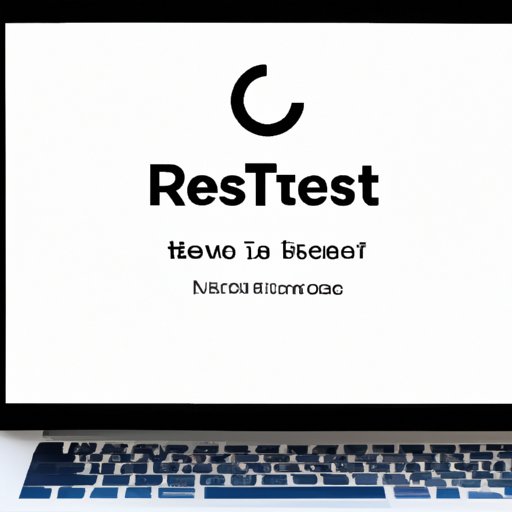
How to Reset MacBook Pro to Factory Settings: A Step-by-Step Guide
Whether you’re looking to clear your MacBook Pro of accumulated clutter or simply trying to start fresh, resetting your device to factory settings can be a great option. In this article, we’ll provide you with a comprehensive guide to accomplish this task. From the benefits of resetting to detailed walkthroughs, common problems and backup solutions, our aim is to make the process as straightforward and easy as possible.
Step-by-Step Guide
Before resetting your MacBook Pro, it’s important to know that the process will erase all data, setting it back to the original factory settings. As such, please make sure that you have a backup of all your data before proceeding.
Step 1: Turn off Find My and sign out of iCloud. Open the Apple menu, select System Preferences, choose iCloud, and then deselect Find My Mac.

Step 2: Restart your MacBook Pro. Click on the Apple menu and select Restart.

Step 3: Enter Recovery Mode. Press and hold down the Command (⌘) + R keys during startup. Once the Apple logo appears, release the keys.

Step 4: Reinstall macOS. In Recovery Mode, select Reinstall macOS and then Continue. Follow the instructions provided on-screen, and click on Continue until you reach the last screen. Select Install to begin the process.

Step 5: Erase data. Once the installer window appears, select Disk Utility and then Continue. Choose your startup disk, select Erase, and then click on Erase again.

Step 6: Reinstall macOS. Return to the installer window, select Install macOS, and then Continue. Follow the instructions provided, and select the startup disk as the destination drive.

Step 7: Setup your MacBook Pro. Once the installation process is complete, your MacBook Pro will restart and begin the initial setup.

Quick and Easy Overview
If you need a quick overview of the resetting process, follow these simple steps.
- Turn off Find My and sign out of iCloud.
- Restart your MacBook Pro by clicking on the Apple menu and selecting Restart.
- Enter Recovery Mode by holding down Command (⌘) + R during startup.
- Reinstall macOS by selecting Reinstall macOS and then Continue in Recovery Mode.
- Erase data by selecting Disk Utility, choosing your startup disk, and then clicking Erase.
- Reinstall macOS by selecting Install macOS in the installer window and following the instructions provided on-screen.
- Setup up your MacBook Pro with your preferences once the installation process is complete.
Troubleshooting Tips
If you encounter any problems while resetting your MacBook Pro to factory settings, some common issues and their solution include:
- Lack of storage space: Clear space on your hard drive to allow the installation process to continue.
- Slow installation process: Check your internet connection and make sure that there are no downloading errors.
- Errors appear: Try starting the process again by restarting your MacBook Pro and entering Recovery Mode as previously described.
- Recovery Mode not working: Contact Apple Support for assistance.
Alternatives to Resetting to Factory Settings
If you’re considering resetting your MacBook Pro but are hesitating, there are many alternatives you can consider, including:
- Clearing out your device by deleting unused files and apps.
- Resetting specific settings rather than all of them, e.g., resetting network settings.
- Consider upgrading your hardware to improve the performance of your MacBook Pro, such as more RAM or storage space.
Consequences of Resetting
Before resetting your MacBook Pro, it’s important to understand the implications. When you reset to factory settings, all of your data is removed from the device. Apple’s built-in apps and services are reset back to their original state, and any third-party apps will need to be reinstalled. However, resetting your MacBook Pro to factory settings can also be seen as a positive solution, especially if you’re looking to start from scratch or improve performance.
Backup Solutions
It’s essential to back up all of your data and files before beginning the resetting process. Apple provides a simple and efficient way to do this via its online backup service, iCloud. Here are the steps to follow:
- Open the Apple menu and select System Preferences.
- Click on iCloud and then turn on iCloud Drive.
- Click on Options next to iCloud Drive and select the apps you want to back up.
- Ensure that Optimize Mac Storage and Desktop and Documents Folders are also selected.
- Wait for your files to upload. Once completed, your files will be accessible on any device signed into the same iCloud account.
Conclusion
Resetting your MacBook Pro to factory settings can seem like a daunting process; however, with the proper preparation, steps, and backup solutions, the process is straightforward and easy. Whether you’re looking to start fresh with your MacBook Pro or improve its performance, resetting to factory settings can be a great solution. By following the step-by-step guide provided, you can achieve this task with confidence.




